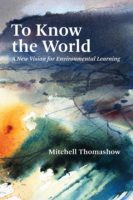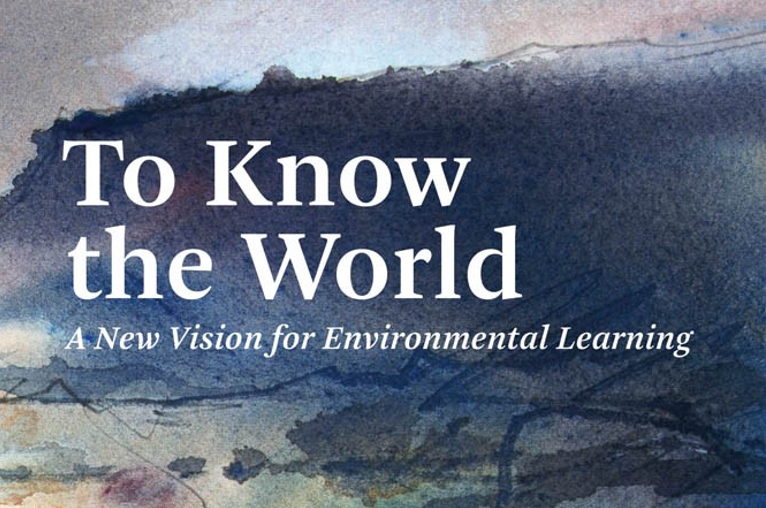 Mitchell Thomashow’s most recent book, To Know the World: A New Vision for Environmental Learning, arrives when we need it most. It is rooted not just in the exigency of climate change, but also in a pivotal historical moment, for tensions surrounding diversity, equity and inclusion in a digital age demand an updated critical approach to both environmental learning and action.
Mitchell Thomashow’s most recent book, To Know the World: A New Vision for Environmental Learning, arrives when we need it most. It is rooted not just in the exigency of climate change, but also in a pivotal historical moment, for tensions surrounding diversity, equity and inclusion in a digital age demand an updated critical approach to both environmental learning and action.
Drawing on over fifty years of environmental experience, Thomashow urges both environmental educators and ecological citizens to heed a call to action where environmental learning is not just a topic for classroom settings but is instead the practice of our everyday lives. To heal the ecological wounds that permeate the biosphere, Thomashow reminds us that we must understand how migration, inequity, and climate justice are all linked. This understanding can ultimately reinvigorate how we think about our connections on Earth, and how we better cultivate those interconnections that span continents, class, gender, and race. Ultimately, through thoughtful reflection, attention to the world around us, and through direct action in our communities, Thomashow reveals possibilities that can lead to a flourishing for all beings.
Skillfully weaving the personal with the practical, Thomashow divides the book into four sections. Part I contextualizes the conversation through a perceptual exploration of ecological memory rooted in place. With the assistance of Harold and the Purple Crayon, Thomashow encourages his readers to adventure back in time to their own childhood memories so that we can not only delight in these foundational connections, but also use these experiences to imaginatively explore and adapt the world around us. It is this spirit of exploration that guides the entire book. In Part II the challenges of digital connectivity in the global context of the Anthropocene are critically examined. Acknowledging the seductive allure of the digital sphere, as well as the potential powers of the medium, Thomashow guides readers on how to constructively curate online interactions, first by attending to the medium itself, and second by assessing the role of the medium in connecting us to what matters most in life. Both educators and students will find chapter 4 – “Is the Anthropocene Blowing Your Mind?” – an essential investigation regarding the fraught role of digital screens in shaping our understanding of the world.
It is in Parts III and IV where Thomashow most directly attends to the practical ways in which individuals can think more critically about the extreme upheaval of our contemporary cultural and ecological networks, while simultaneously exploring productive means of addressing those radical changes. Through grounded activities, like those which stress the power of connectivity through the mapping of social and ecological networks, Thomashow reminds educators of all disciplines to make visible the threads of globalization that are too frequently invisible. In the process, we are reminded as individuals about the power of expanding our understanding of migration through what he refers to as “cosmopolitan bioregionalism” a hybrid approach which serves to bridge the divides that too frequently polarize cultural and ecological discourse like urban vs. rural, insider vs. outsider, and place based vs. cosmopolitan.
Finally, moving from the global to the individual, Thomashow eloquently reminds us of the value of embedding our own perceiving body into a wider network of being. Through coalition building that takes place not just with other humans, but also with the places where we ground ourselves, Thomashow encourages readers through place-based activities to cultivate excellence as we each strive to become a “good creature.” Indeed, To Know the World might be best described as a guide for how to have a conversation with the world beyond our heads: with communities composed of humans and more-than-humans, and to find inspiration and guidance from networks that can range from LGBTQ+ activists to the mycorrhizal fungi beneath our feet.
Blending the philosophical with the practical, the book takes readers on a journey that explores individual thinking rooted within complex ecosystems. With resources that include not just practical applications of theoretical concepts throughout the book, but also recommended readings, a glossary of key terms, and templates for environmental learning activities that could be adapted to a wide range of age groups and disciplines, this is an essential addition for environmental educators who wish to transform thinking, connections, and action.





